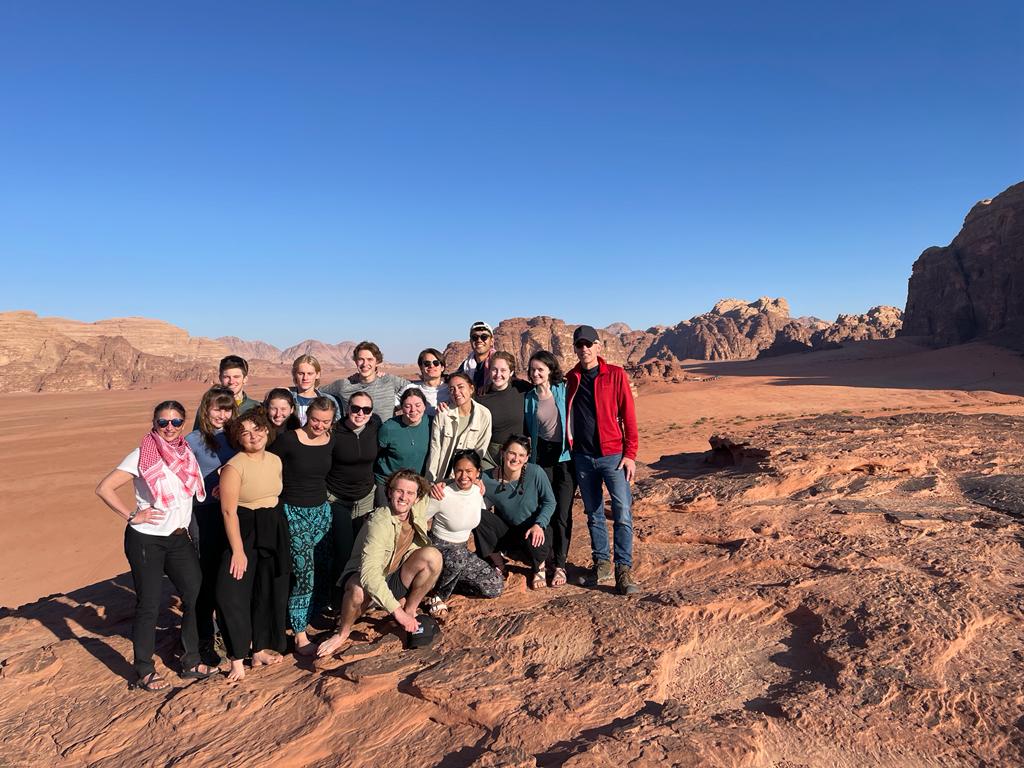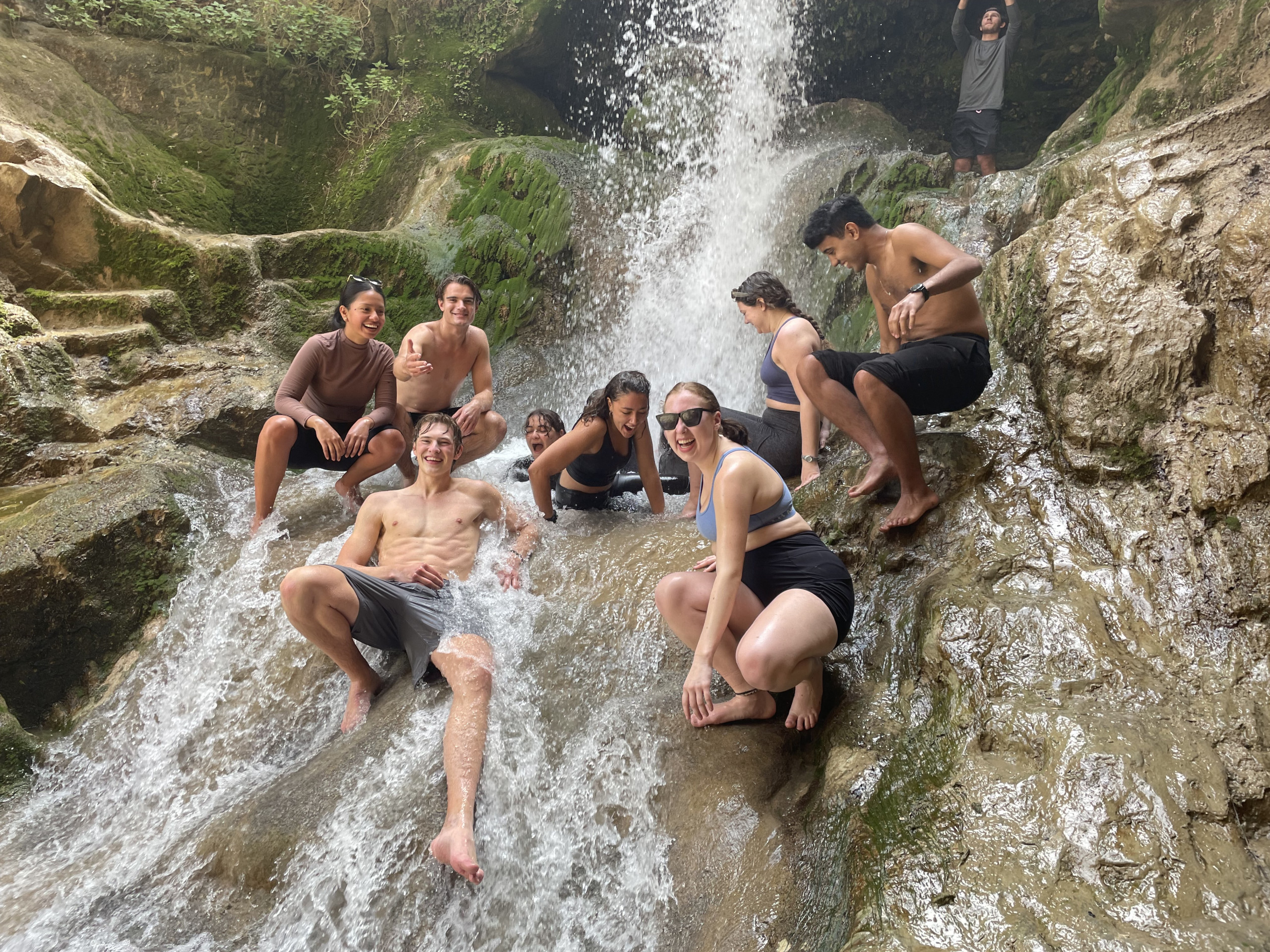Everywhere but Amman
This week we left the hustle and bustle of Amman behind for our first and only multi-day, overnight excursion in Jordan, visiting Wadi Rum, Petra, the Dead Sea, and an eco-lodge in northern Jordan.
“Are we sure we’re not in South Dakota?” – Freya Gordon, March 26th
We began our excursion with a four-hour bus ride to Wadi Rum in southern Jordan. In mid-afternoon, we arrived at a town on the edge of Wadi Rum and proceeded to mount pick-up trucks lined with cushions which would take us to our campsite. I couldn’t help but grin during the whole ride. There was desert as far as the eye could see; towering red mountains, rocky canyons, and soft cayenne-colored sand.
We spent the afternoon riding in pickup trucks and visiting various rock formations. Several of the boys attempted to climb the first canyon we visited. Lars and Freya successfully did the “Dirty Dancing Lift” at the top of one of the rock formations, while Ben, Inna, and Jossy had a photoshoot before we all sat and watched the setting sun. I stood in awe of how vast and beautiful the desert was, humbled by how unaware I had been that a place like Wadi Rum exists. This would not be the first time I would have this feeling on this excursion. We spent the night at a traditional Bedouin camp, eating a dinner cooked entirely underground, chatting and dancing with the owners of the camp and other students until midnight.
When you google “Wadi Rum,” it’s not entirely clear what the site is all about. I knew it would be desert, but what I did not expect were views that reminded me of Arizona or South Dakota, and weather cold as a spring night in Minnesota. We were in a location so remote and so dry that, at night, I could run my hand across my bed and see flickers of light running between my fingertips and the sheets. Though most of us had freezing, horrible nights of sleep and were startled by the cold when we awoke, watching the morning sun glisten on the red rocks as we ate breakfast made it all worthwhile.

“I’ve been trying not to ask this, but do you know what Petra is?” — Aerin O’Malley, March 27th
Petra is an ancient city, once a capital of the Nabataean Empire. It remains unknown when Petra was built, but the capital began to thrive in 100 BC, and was eventually annexed by the Roman Empire until an earthquake in 400 AD destroyed most of the city. Decked out in our best hiking boots, we entered Petra in mid-afternoon. As we walked, our guide, Ala, pointed out ancient carvings of icons on the wall and informed us about the history of Petra. The tour ended mid-way into the ancient city, and from there we had free time to explore. We all elected to take the massive climb up to the monastery, huffing and puffing as we climbed each of the 1,000 steps, respectfully declining invitations from vendors to stop and shop during the hike. Once we reached the top, I rested and, once again, was humbled by the ancient ruins.

“This doesn’t make any [expletive] sense,” – Gabriel Marinho, March 28th
On our third day, we visited the Dead Sea. Located at 430 feet below sea level, the Dead Sea is the lowest point on Earth. Tragically, the sea level drops one meter every year; it is literally a dying sea. The sea is known for its magical healing powers, known to significantly improve psoriasis and have anti-aging properties, especially if you choose to cover yourself in a Dead Sea mud mask (which we all did). We had heard stories about how its high salt content enabled you to literally lay down and read a book while floating on top of it. Skeptically, I entered the sea and was amazed at how easily I floated, laying down completely with my body sitting atop the water, but struggling to get myself upright again without getting the nasty, intensely salty water in my mouth or eyes. As I lathered myself up with mud and sat down to let it dry,, I looked out onto the sea and couldn’t believe that just across the sea was Israel.
“Surprise hike!” — All of us, every time we end up hiking without warning on Global
Spending the night at an eco-lodge in northern Jordan, we were reminded of the environmentalism we studied in Ecuador. Walking to our bus after experiencing the Dead Sea, many of us reflected on how easy our stay would be at the eco-lodge, given how many of our days in Ecuador were characterized by compost toilets, four-hour hikes, and zero electricity. But as the bus attempted to turn into the entrance of the park, it immediately retreated. Before our leaders could say it, we knew what was coming: “Surprise hike!” we all shouted. And so it was, and we walked a little over a mile to our lodging, laughing and chatting the whole way.
The next morning, we prepared for an easy two-hour hike around the Zyglab dam, a precious water reservoir that was recently empty, but due to a good rainy season, now has water. More than anything, the dam is representative of the politics involved in Jordan’s water crisis. Jordan is the fourth poorest country in terms of water and imports most of it from Israel. As we hiked in the mountains that surrounded the eco-lodge, I was once again humbled, this time by how often I take for granted the easy access to potable water we have in the United States. Eventually we arrived at a waterfall, initially just marveling from afar, due to water blocking our path. But when our guide told us to keep going into a small creek, we all took a beat, began untying our hiking boots, and shouted, “Surprise swim!” It ended up being one of the best moments of the excursion, all of us splashing around in the waterfall, grinning from ear-to-ear at the spontaneity of it.

You must be logged in to post a comment.